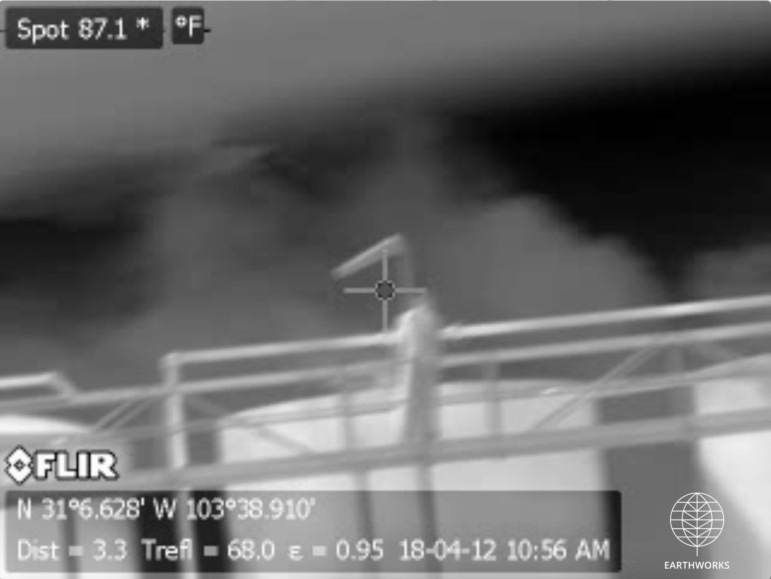Standing on the parking lot of Northridge Highschool in Greeley, Colorado, looking across the athletic field to the oil and gas tanks on the other side, was the first time I witnessed an oil and gas worker thieving tanks and offloading liquids. That’s when I learned about the openings on tanks called thief hatches.
It was September 14, 2014, and I was recently certified as an optical gas imaging thermographer, but I had no idea what I was witnessing. Bruce Baizel who is now NMED legal director, was with me. As I described the huge black blob of hydrocarbon gases rising up from the tanks and traveling to the nearby neighborhood homes, Bruce grabbed the binoculars and noted that the workers walking on the tanks were wearing no protective gear.
In response to the media and Northridge High School PTA, the operator, Synergy Resources Corporation, admitted that the tank hatch was open while an oil truck was being filled. He said, “That happens. That’s part of the industry. For that 20-30 minutes it takes to load the truck, the hatch is open.” Greeley Tribune
There were ten tanks on the site holding liquids and no one could or would tell me how many times a day each of those tanks had the hatch open for “that 20-30 minutes” while the workers stood in the plume and the neighborhood and highschool students got engulfed in a cloud of hydrocarbon gasses.
At a Texas site, a worker told me that they do not want the gas in the trucks, only the liquids, so the gas has to go into the air. “That’s the only way we can do it,” he said.
Tanks on oil and gas sites hold liquids like oil, condensate and waste water, they do not hold gas. All those liquids come up from the formation mixed with volatile organic compounds. The volatile gases separate or offgas from the liquids and rise to the top of the tanks creating pressure that can cause explosions if the gas is not released. When workers open the hatches, gases, under pressure, blast out.
I’ve seen workers engulfed in giant clouds of hydrocarbon gas plumes during drilling, workovers, offloading liquids, site maintenance and “thieving.” Of these, “thieving the tanks” which is when a worker opens the tank hatches to take measurements and samples of the liquids, seems the most dangerous. A worker’s face is directly over a hole that is blasting out volatile organic compounds and potentially deadly gases.
At least nineteen men have died during liquids offloading and thieving. OSHA and NIOSH issued a hazard alert and recommendations to keep workers safe. Voluntarily following recommendations is rare for the oil and gas industry. I still see workers on the tank catwalk thieving tanks alone with no breathing protection.
I have documented thieving over a dozen times and it seems to routinely take about 40 minutes. First the worker walks along the catwalk and opens all the tank hatches which allows a mushroom cloud of hydrocarbon gases to escape creating an intense exposure for the workers, nearby neighbors, local air quality and our climate.

Only once have I seen a worker with a self contained air system that is recommended. The other times workers were without any breathing protection just like the toddler that might be playing in their backyard a few hundred feet away. If this practice can kill a grown man onsite, what might it do to that toddler?
The young man in this video was about my youngest son’s age. The video is in focus but the amount of gas engulfing him makes it seem unfocused. This site was fitted with vapor recovery that prior to this event. The purpose of vapor recovery is to capture emissions from tanks for sales or incineration. Many of the thieving videos I’ve recorded were at sites with vapor recovery. What purpose does a vapor recovery system serve when the tank hatches are opened as often as “a dozen times in one day” while thieving takes place? This site routes the gas to a flare with the intent to incinerate the emissions. Like many flares I find, it’s often unlit and venting and like many sites I visit, tank hatches are often left open or only partially closed.
The American Petroleum Institute “recommends” Standard 21 that would prevent opening tank hatches to take measurements and samples. The industry only follows this standard where it is mandated. A mandate that requires the industry to provide an alternative to opening tank hatches could save workers’ lives and protect their health and the toddler next door, it would protect local air quality and our climate.
